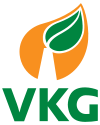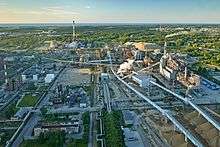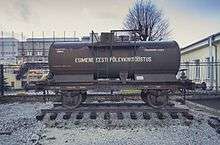Viru Keemia Grupp
 | |
| Private | |
| Industry |
Oil shale industry Power generation |
| Predecessor |
Riigi Põlevkivitööstus AS Esimene Eesti Põlevkivitööstus Slantsehim RAS Kiviter |
| Headquarters | Kohtla-Järve, Estonia |
Key people | Priit Rohumaa (CEO)[1] |
| Website |
www |
Viru Keemia Grupp (VKG) is an Estonian holding group of oil shale industry, power generation, and public utility companies.
History
After Estonia gained independence, the state owned oil shale enterprise, Riigi Põlevkivitööstus (English: Estonian State Oil Shale Industry), was established as a department of the Ministry for Trade and Industry on 24 November 1918. Shale oil production started in Estonia in 1921 when Riigi Põlevkivitööstus built 14 experimental oil shale processing retorts in Kohtla-Järve.[2][3] These vertical retorts used the method developed by Julius Pintsch AG that would later evolve into the current Kiviter processing technology.[3] Along with the shale oil extraction plant, an oil shale research laboratory was founded in 1921.[4] Following the experimental retorts, the first commercial shale oil plant was put into operation on 24 December 1924. This is considered as a beginning of the history of Viru Keemia Grupp.[5]
In October 1936, Riigi Põlevkivitööstus was reorganized as the government-owned joint stock company and was renamed Esimene Eesti Põlevkivitööstus.[6] It operated three shale oil extraction plants and was constructing the fourth plant. After occupation of Estonia by the Soviet Union, the company was subordinated to the Soviet authorities in December 1940.[7] During the subsequent German occupation, the industry was merged into a company named Baltische Öl GmbH, subordinated to Kontinentale Öl.[8][9]
During the following Soviet occupation, the company became the Kohtla-Järve shale oil combinate (Russian: Сланцехим under the General Directorate of Synthetic Liquid Fuel and Gas of the USSR (Glavgaztopprom).[10] In 1948, the company opened an oil shale gas plant, and for several decades the oil shale gas was used as a substitute for natural gas in Saint Petersburg (then known as Leningrad) and in northern Estonian cities.[11][12] It was the first time in history that synthetic gas from oil shale was used in households.[13]
In 1995, the Kohtla-Järve factory and factory in Kiviõli were merged into the single company named RAS Kiviter.[14] In 1997, Kiviter was privatized and a year later it declared insolvency. Its factory in Kohtla-Järve was acquired by newly established Viru Keemia Grupp.[15]
In 2008, the company received a permit for developing the Boltysh oil shale deposit in Ukraine.[16]
VKG Oil opened three new Galoter-type oil plants called Petroter correspondingly in December 2009, in October 2014, and in November 2015.[17][18][19]
In January 2016, the company announced that due to low oil price, it will close the old oil plants using Kiviter technology and lay off 500 workers.[20]
Operations
VKG's two main areas of operations are shale oil extraction, and electricity and heat production and distribution.
Shale oil production

The subsidiary producing shale oil is VKG Oil. The company utilizes two different processes: Kiviter and Galoter.[21][22][23][24] The company also tested but rejected the Alberta Taciuk Process.[25] In total, VKG Oil processes 2 million tons of oil shale per year, producing 250,000 tons of shale oil.
The company operates several Kiviter retorts, the largest of them having a processing capacity of 40 tonnes per hour of oil shale feedstock.[15][26] These retorts are currently out of operation due to low oil price.[20] It also operates three Galoter-type retorts called Petroter.[24] Engineering of the retort was done by Atomenergoproject of Saint Petersburg; engineering of the condensation and distillation plant was done by Rintekno of Finland.[27] The first Petroter plant has a processing capacity of 1.1 million tonnes of oil shale per year and it produces 100,000 tonnes of shale oil, 30 million cubic metres (1.1×109 cu ft) of oil shale gas, and 150 GWh of steam per year.[24]
Power generation and distribution

VKG's subsidiary VKG Energia, a power and heat generation company, was established in 2004 after VKG bought the Kohtla-Järve Power Plant and the Kohtla-Järve heat distribution system from Kohtla-Järve Soojus.[28] In 2005, it bought another power plant in Kohtla-Järve from Fortum Termest.[29] In 2006, VKG bought a 40,8% stake in Kohtla-Järve Soojus, an operator of the Ahtme Power Plant, and in 2010 it took a full control of the company, now VKG Soojus.[30][31] All generations capacities were transferred to VKG Energia while VKG Soojus is responsible for heat distribution.[31][32] All generations capacities were transferred to VKG Energia while VKG Soojus is responsible for heat distribution.[31] VKG Energia has installed electrical capacity of 80 MW and heat capacity of 700 MW.[33]
In July 2006, VKG acquired Narva Elektrivõrk, the second largest power distribution company in Estonia,[34] and renamed it VKG Elektrivõrgud.[35][36][37]
Other activities
In April 2011, VKG acquired assets of a bankrupt company Silbet Plokk that manufactured cinder blocks for construction from oil shale burning residue.[1][38][39] The company was renamed VKG Plokk.[39]
Subsidiaries

Main subsidiaries of VKG are:
- VKG Oil - shale oil producer
- Viru RMT – company producing, assembling and repairing metal structures, pipelines and pressure equipment
- VKG Transport – transportation company
- VKG Energia - heat and power generation company
- VKG Soojus – heat distribution company
- VKG Elektrivõrgud – electricity distribution company
- VKG Elektriehitus – construction of power systems
- VKG Kaevandused – oil shale mining
- VKG Plokk – production of cinder blocks
- OOO Slantsehim (73.4%) – developer of Boltysh oil shale deposit in Ukraine
Bibliography
- Aaloe, Aasa; Bauert, Heikki; Soesoo, Alvar (2007). Kukersite oil shale (PDF). Tallinn: GEOGuide Baltoscandia. ISBN 978-9985-9834-2-3.
- Holmberg, Rurik (2008). Survival of the Unfit. Path Dependence and the Estonian Oil Shale Industry (PDF). Linköping Studies in Arts and Science. 427. Linköping University.
- Ots, Arvo (2006) [2004]. Tyson, Toni; McQuillen, Mary, eds. Oil Shale Fuel Combustion. Tallinn: Arvo Ots; Eesti Energia. ISBN 978-9949-13-710-7.
References
- 1 2 Hõbemägi, Toomas (2011-04-12). "Viru Keemia Group buys bankrupt maker of cinder blocks". BNN. Retrieved 2011-07-09.
- ↑ Ots (2004), pp. 15–16
- 1 2 Lindquist, W. (1937-09-11). "Estländska oljeskifferindustrien" [Estonian oil shale industry]. Teknisk Tidskrift. Kemi (in Swedish) (9): 71–75. Archived from the original on 2014-07-23. Retrieved 2014-03-31.
- ↑ Aaloe et al. (2007), p. 21
- ↑ Aleksandrov, Julia (2009). "85 Years of Oil Shale Processing in Estonia" (PDF). Oil Shale. A Scientific-Technical Journal. Estonian Academy Publishers. 26 (4): 540–543. ISSN 0208-189X. Retrieved 2016-01-17.
- ↑ Holmberg (2008), p. 99
- ↑ Holmberg (2008), p. 129
- ↑ Uibopuu, Lembit. "Saksa kapital Eesti põlevkivitööstuses (1922–1940) ja Eesti põlevkivitööstus Saksa okupatsiooni ajal (1941–1944)" [The German capital in Estonian oil shale industry (1922–1940) and the Estonian oil shale industry during the German occupation (1941–1944)] (in Estonian). Tallinn University of Technology. Archived from the original on 2014-10-26. Retrieved 2014-04-05.
- ↑ Holmberg (2008), pp. 130–131
- ↑ Holmberg (2008), p. 137
- ↑ Valgma, Ingo. "Map of oil shale mining history in Estonia". Tallinn University of Technology. Archived from the original on 2014-08-17. Retrieved 2008-10-25.
- ↑ Holmberg (2008), p. 139
- ↑ Holmberg (2008), p. 135
- ↑ "Estonian Energy 1991–2000" (DOC). Ministry of Economic Affairs. 2001. p. 85. Archived from the original on 2014-12-09. Retrieved 2014-12-09.
- 1 2 Koel, Mihkel (1999). "Estonian oil shale". Oil Shale. A Scientific-Technical Journal. Estonian Academy Publishers (Extra). ISSN 0208-189X. Retrieved 2008-11-23.
- ↑ "Viru Keemia Grupp starts analysing Ukrainian oil shale". BNN. 2008-02-12. Retrieved 2011-07-09.
- ↑ Hõbemägi, Toomas (2009-12-22). "VKG opens Estonia's most modern oil refinery". BBN. Archived from the original on 2014-11-10. Retrieved 2011-07-09.
- ↑ "Viru Keemia Group Opens Second Shale Oil Plant". ERR. 2014-10-08. Archived from the original on 2014-12-01. Retrieved 2015-01-04.
- ↑ "VKG avas põlevkivitöötlemise tehase Petroter III" [VKG opens Petroter III oil shale processing plant]. Postimees (in Estonian). BNS. 2015-11-11. Archived from the original on 2014-12-01. Retrieved 2016-01-17.
- 1 2 "VKG to lay off 500 workers". ERR. BNS. 2016-01-15. Archived from the original on 2016-01-17. Retrieved 2016-01-17.
- ↑ Siirde, A.; Roos, I.; Martins, A. (2011). "Estimation of emission factors for the Estonian shale oil industry" (PDF). Oil Shale. A Scientific-Technical Journal. Estonian Academy Publishers. 28 (1S): 127–139. doi:10.3176/oil.2011.1S.05. ISSN 0208-189X. Retrieved 2011-07-09.
- ↑ Jaber, Jamel O.; Sladek, Thomas A.; Mernitz, Scott; Tarawneh, T. M. (2008). "Future Policies and Strategies for Oil Shale Development in Jordan" (PDF). Jordan Journal of Mechanical and Industrial Engineering. 2 (1): 31–44. ISSN 1995-6665. Retrieved 2008-11-22.
- ↑ "Strategic significance of America's oil shale resource. Volume II: Oil shale resources, technology and economics" (PDF). Office of Deputy Assistant Secretary for Petroleum Reserves; Office of Naval Petroleum and Oil Shale Reserves; United States Department of Energy. 2004. Retrieved 2008-11-23.
- 1 2 3 Aleksandrov, Julia; Purga, Jaanus (2010). "Viru Keemia Grupp opened a new oil shale processing plant in Estonia" (PDF). Oil Shale. A Scientific-Technical Journal. Estonian Academy Publishers. 27 (1): 84–85. ISSN 0208-189X. Retrieved 2011-03-20.
- ↑ "Estonian oilshale group tests new technology in Canada". BNN. 2002-09-09. Retrieved 2011-07-09.
- ↑ "An Assessment of Oil Shale Technologies" (PDF). June 1980. NTIS order #PB80-210115. Retrieved 2008-11-23.
- ↑ "New shale oil line for VKG Oil AS" (PDF). Rintekno Newsletter. Rintekno Oy. 20. 2006. Archived from the original (PDF) on 2007-09-20. Retrieved 2008-12-13.
- ↑ Gamzejev, Erik (2004-06-01). "Järve linnaosa kütjaks võib saada Viru Keemia Grupp" [Viru Keemia Grupp may become a heat supplier of the Järve district]. Põhjarannik (in Estonian). Retrieved 2012-10-27.
- ↑ "Viru Keemia Grupp ostis Fortumilt soojuselektrijaama" [Viru Keemia Grupp acquired a thermal power plant from Fortum]. Äripäev (in Estonian). 2005-10-25. Retrieved 2012-10-27.
- ↑ Jaagant, Urmas (2010-10-20). "Viru Keemia Grupp soovib osta osalust Kohtla-Järve Soojuses" [Viru Keemia Grupp wants buy a stake in Kohtla-Järve Soojus]. Eesti Päevaleht (in Estonian). Retrieved 2012-10-27.
- 1 2 3 Tooman, Artur (2011-06-21). "Kohtla-Järve Soojus переименовали" [Kohtla-Järve Soojus was renamed]. Eesti Päevaleht (in Russian). Retrieved 2012-10-27.
- ↑ Räim, Veiko (2010-12-22). "Eesti Energia to sell 59.2% of Kohtla-Järve Soojus" (Press release). Eesti Energia. Retrieved 2012-10-28.
- ↑ "VKG Energia OÜ". Viru Keemia Grupp. Retrieved 2012-10-27.
- ↑ "Estonian Electricity and Gas Market Report" (PDF). Tallinn: Energy Market Inspectorate. 2007. Retrieved 2011-07-07.
- ↑ Reinap, Aivar (2006-07-01). "Viru Keemia Grupp ostis Narva Elektrivõrgud" [Viru Keemia Grupp bought Narva Elektrivõrgud]. Postimees (in Estonian). Retrieved 2011-07-09.
- ↑ Kuimet, Peeter (2006-07-14). "VKG ja Narva Elektrivõrgu koondumisele anti roheline tuli" [Green light for the concentration of VKG and Narva Elektrivõrgud]. Postimees (in Estonian). Retrieved 2011-07-09.
- ↑ "VKG ostis kaks Narva elektrifirmat" [VKG bought two electric companies in Narva]. Äripäev (in Estonian). 2006-07-03. Retrieved 2011-07-09.
- ↑ Roman, Steve (2011-04-12). "VKG Acquires Cinder Block Production Facility". ERR. Retrieved 2011-07-09.
- 1 2 Teesalu, Ingrid (2011-10-17). "Factory in Ahtme Revives Production of Cinder Blocks". ERR. Retrieved 2011-10-19.
External links
| Wikimedia Commons has media related to Viru Keemia Grupp. |
